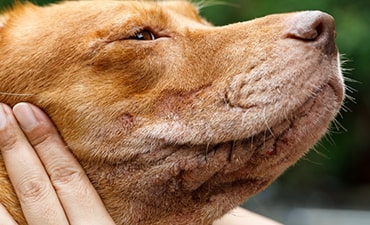Dermatitis (red, inflamed, sore skin or a rash) in dogs
Overview
Has your dog got red, inflamed, angry looking skin? Or do they have a rash? We often call these symptoms ‘dermatitis’.
Skin problems can be very irritating and painful and can be caused by many different things.
Dermatitis should always be checked by a vet, it’s often something that can be easily treated but could be a sign of something more serious.
Symptoms to look out for
- A rash, spots or pimples
- Red, inflamed or sore skin
- Itchy skin
- Hair loss (alopecia)
- Dandruff (dry, flaky skin)
- Oily skin
- Smelly, weepy skin (pyoderma)
- Discoloured skin (brownish as if dirty)

Severe dermatitis around a dog's mouth.
Causes
Fleas and other parasites
- Fleas are a common problem in dogs. They cause itchy, red, skin rashes, especially around the lower back.
- Mange is caused by the scabies mite. These tiny insects cause itchy, red and thickened with patchy hair loss. Mange can also make people who handle the dog have itchy spots.
- Demodex mites are tiny insects that normally live on a dog’s skin without causing problems. If a dog is unwell or their immune system isn’t working properly the mites cause thickened, crusty skin and hair loss, especially on their head, feet and around their eyes. Demodex is more common in puppies than adult dogs.
- Ringworm causes circular patches of red, raised, hairless, itchy skin. Fortunately, ringworm is quite rare in dogs.
Allergies
- Allergic skin disease causes itchy skin and rashes.
- Food allergies often cause a rash and itchy skin.
- Medication reactions can sometimes cause red, itchy skin and a rash.
- Severe allergic reactions can cause hives, rashes and swellings anywhere on the body. Contact your vet ASAP if you suspect your dog is having a severe allergic reaction – this is an emergency.
Skin infections
- Bacterial infections often cause red, inflamed circular patches on the skin that smell pungent.
- Puppy pyoderma (juvenile eczema) is a common bacterial infection in young dogs.
- Hot spots (wet eczema or acute moist dermatitis) tend to appear quickly and cause smelly, weepy, itchy skin.
- Yeast infections may cause your dog to develop a sour smell and a greasy coat.
Bruises
- If your dog has developed a rash that looks like blood spots or bruising it could be a sign of a blood clotting disorder. This is something you need to see your vet about ASAP.
When to contact your vet
Skin problems can cause a lot of suffering, have your dog examined by a vet as soon as you notice a skin problem.
You know your dog best. If they don’t have the symptoms listed above but you are still concerned it’s always best to contact your vet.
When you welcome a new dog into your life, consider getting dog insurance straight away before any signs of illness start. This will give you peace of mind that you have some financial support if they ever get sick.
Published: October 2018
Did you find this page useful?
Tell us more
Please note, our vets and nurses are unable to respond to questions via this form. If you are concerned about your pet’s health, please contact your vet directly.
Thank you for your feedback
Want to hear more about PDSA and get pet care tips from our vet experts?
Sign up to our e-newsletter
Written by vets and vet nurses. This advice is for UK pets only. Illustrations by Samantha Elmhurst.

